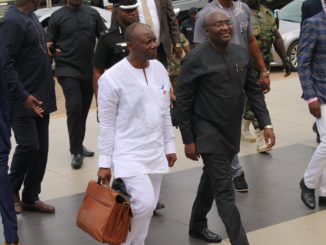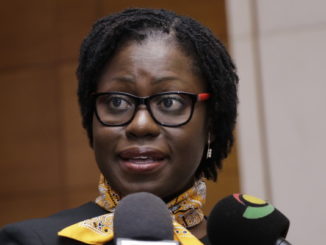Nana Akufo-Addo, Ghana’s President, rode to election victory on a wave of slogans that promised rapid industrialisation and a massive growth in jobs. But two years on, how much, if any progress on these pledges has been made? Rafiq Raji discusses.
Nana Akufo-Addo, the president of Ghana, is a great speaker. People listen in awe to his speeches, marvelling at his mastery of language. He defeated an incumbent to the coveted position he now occupies with relative ease but his oratory was not all that won the votes of the majority of his compatriots. He sold a dream of an industrialised Ghana that would look ‘beyond aid’ for development.
At the time, during the campaigns and after he was sworn into office, analysts wondered just how realistic his ‘One district, one factory’, ‘One village, one dam’ proposals were. Still, the citizens bought the dream with relish. And to his credit, he was not just selling a dream – he meant to realise it.
This is not the first time such an experiment would be attempted in Ghana. Kwame Nkrumah, Ghana’s first President, had a similar vision and he too was determined to make it come true. Yet, as history informs us, even the planned economies such as China which initially underpinned the policies, have had the wisdom of allowing market forces to determine certain things. It seems the lesson has filtered through.
Yofi Grant, chief executive of the Ghana Investment Promotion Centre, told the UK’s Financial Times in September 2017, that “this time around it’s going to be private-sector driven, with government only playing a facilitatory role.” What is the progress report two years later? Speaking to the Financial Times in October 2018, Joyce Awuku-Darko Osei, head of the transformation unit at the Finance Ministry, which prepared the current government’s Ghana Beyond Aid development framework, said poor co-ordination is one reason why progress has been slow.
“Only 600 of more than 1,000 factory proposals have been evaluated,” she explained. Elaborating on Akufo-Addo’s slogans, she said: “The idea is that private businesses can request government assistance (feeder roads, power supply, access to credit, etc) to make factories viable.” Still, how likely is it that there would be an industrial venture worthy of investors’ capital in every district? What do analysts think?
Malte Liewerscheidt, vicepresident for West Africa at Teneo Intelligence in London, told New African that “at about half-time of Akufo-Addo’s first term, the ‘One district, one factory’ policy has still to get off the ground. “As of October 2018, a mere 18 factories of varying size have been built in the 216 districts. The sluggish progress on one of the government’s flagship policies makes it rather unlikely that the stated target will be achieved by 2020.”
Liewerscheidt questioned whether this ‘shotgun approach’ – as he put it – to industrialisation will yield sustainable results. Verner Ayukegba, principal analyst for sub-Saharan Africa at IHS Markit in London, said that the expectation that industrialisation will tackle such socio-economic challenges as high youth unemployment is an impracticable approach. For instance, he said, “Factories need support infrastructure and other support services, which it is impossible to have in all districts. Thus the concentration in Accra, Tema, [and] Takoradi is likely to continue.”
Issue of affordability
There is also the issue of affordability. With public debt at more than 60% of GDP, can Ghana afford more indebtedness in pursuit of these ambitions? Verner Ayukegba is unequivocal: “No! They’ve had to display immense creativity to get the Chinese to finance key projects, with strong IMF opposition.” China has agreed to fund various infrastructure projects to the tune of $19bn in a deal signed during a state visit by President Akufo-Addo in early September, ahead of the Forum on China Africa Cooperation (FOCAC) in Beijing.
More significant for the Chinese, though, is the estimated 960m metric tonnes of bauxite reserves, worth about half a trillion dollars when processed into aluminium, that they hope to exploit in the 26,000 hectare Atiwa forest in southeastern Ghana. In a first phase, Sinohydro Corp Ltd agreed to pay the government $2bn in the latter part of 2018 as part of a barter deal to fund road projects in exchange for refined bauxite.
The government also plans to tap the Eurobond markets for as much as $5bn to $10bn before end 2018 as the first tranche of its proposed century bonds of $50bn, an amount almost equal to the current size of the economy. The government is probably banking on crude oil revenues to meet its debt obligations. But if there is an expected production level of 250,000 barrels per day by 2020, then even if twice as much could be added soon after, it is unrealistic for the administration to bank on oil revenues in this regard.
That said, there are early indications of investment interest from foreign manufacturers. In early September, the government signed an MoU with Sinotruck International, the Chinese maker of heavy-duty vehicles, to build an assembly plant, which would initially produce about 1,500 trucks annually, with room for further expansion. The deal was struck not too long after Volkswagen, the German automaker, also announced it was in talks with the government about building an assembly plant.
Refine policy, set realistic targets
Without a doubt, there is a strong imperative to grow the manufacturing base, even though crude oil production is expected to boost growth for a while, with the IMF projecting an average growth rate of about 6% per cent in 2018-22; after an average acceleration of about 7% over the past decade. Industry still provides about a third of national output despite registering the highest sectoral growth at about 16%.
Services, which is not as labour-intensive, takes the lion’s share at about 40%. As industry creates more jobs, the issue is not so much about the need to boost the sector as it is about the approach being taken. But what is the alternative to maintaining the momentum towards an industrialised Ghana?
“There is no alternative than for government to maintain that narrative, at least from an aspirational standpoint”, said IHS Markit’s Ayukegba. But the government could also “focus more on regionally-focused clusters to create economies of scale, which countries such as China have pursued with sometimes remarkable success,” suggested Teneo’s Liewerscheidt.
In any case, “automation in agriculture and industry would erode the benefits of such policies for employment over time,” argued Ayukegba. What can the government do then to improve the policy so that it achieves the objectives of industrialisation?
“Injecting power and other infrastructure investment to make the cost of production and doing business cheaper” is one approach, according to Ayukegba, and boosting the services sector is another. The government’s five-pillar Ghana Beyond Aid development framework of wealth creation, inclusivity, sustainability, empowered Ghana and resilient Ghana (WISER) already incorporates these considerations. So the issue is not so much about policy objectives as it is about a practical, optimal and sustainable approach.
–
newafricanmagazine.com




